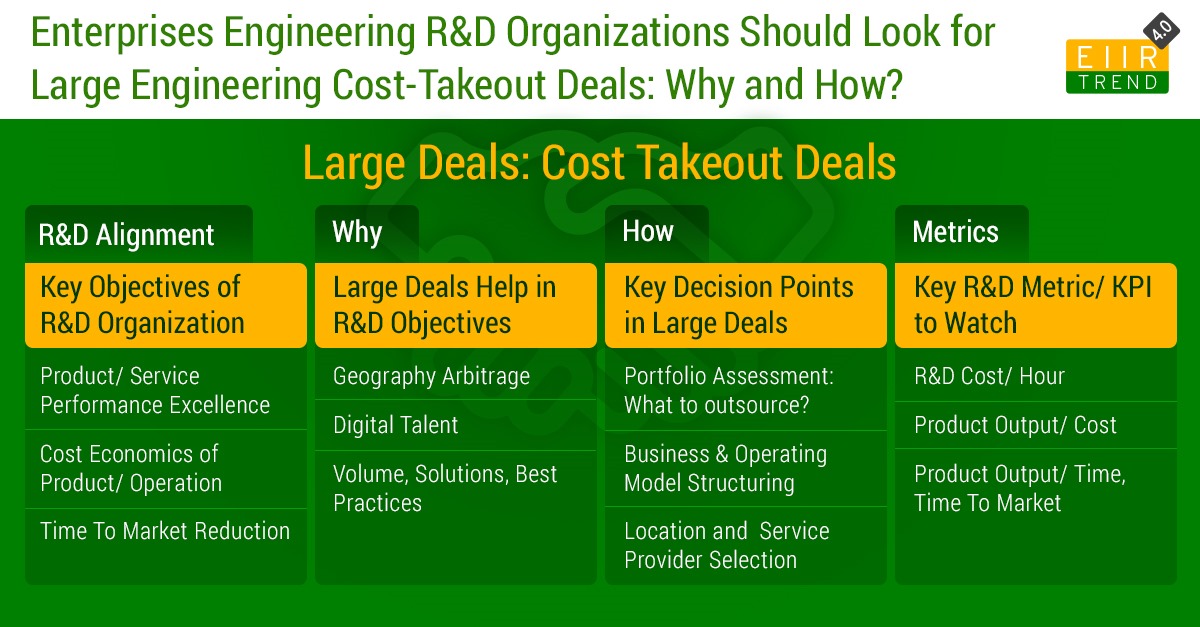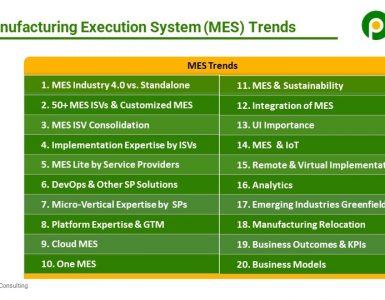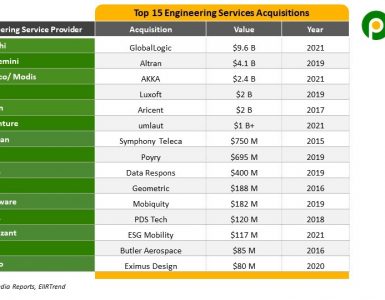The R&D organizations within engineering enterprises shoulder one of the world's most critical and demanding responsibilities. Their mandate is clear: to develop world-class products and services that drive their enterprise's success. Indeed, an enterprise's very existence hinges upon its ability to meet customer needs through these offerings, presenting a substantial opportunity for R&D. However, this pursuit is not without its challenges, as R&D departments grapple with various constraints. In this context, embracing large engineering cost take-out deals can assist enterprises in capitalizing on this opportunity while navigating the associated challenges.

Objectives of Enterprises’ R&D Organizations
There are multiple R&D objectives, but key objectives can be categorized into one of the following three areas:
- Product/ Service Performance Excellence: Every enterprise aims to deliver top-notch products and services with valuable features, exceptional quality, and an outstanding customer experience. However, the challenge lies in achieving these objectives within the constraints of a limited budget and time frame.
- Cost Economics of Product/ Operations: Enterprises work diligently to align the cost of their R&D operations with their corporate budget and strategic goals. Additionally, many enterprises seek to reduce the unit cost of their products, enhancing their competitiveness and expanding their market potential.
- Time to Market Reduction: With product lifecycles becoming shorter and intense competitive pressures, introducing new products and updates swiftly is vital for increasing product revenue and profitability. In this fast-paced environment, the sooner enterprises bring their offerings to market, the more advantageous it is for their overall success.
Large Cost take-out Deals Can Help Enterprises in Achieving Their R&D Objectives
So, how exactly do large cost take-out deals assist enterprises in attaining their R&D objectives? There are several key factors to consider, but we will emphasize the three most significant ones:
- Geography Arbitrage: Significantly different salary levels and cost of living exist between the United States, European countries, many APAC countries, and India. Enterprises can tap into a vast pool of high-quality talent cost-effectively. Over the past three decades, numerous engineering enterprises have witnessed the advantages of this firsthand.
- Digital Talent: In the past, engineering enterprises were primarily focused on traditional mechanical and electrical engineering. However, with the emergence of smart products and services, there is a growing need for engineering and digital expertise in embedded systems, software engineering, cloud, analytics, AI, etc. Attracting this digital talent can be a challenging task for many engineering enterprises. Collaborating with service providers in large cost take-out deals ensures a consistent influx of engineering and digital talent.
- Volume, Solution, Best Practices: Cost take-out deals can generate additional capacity, which can be instrumental in enhancing product quality, accelerating the development of new products and features, increasing testing capabilities, and reducing project timelines. Beyond the capacity advantages, service providers can bring their solutions and best practices cultivated through working with various customers. This infusion of knowledge can lead to improvements in cost-efficiency, quality, performance, and project timelines.
Key Decision Points in Large Cost Take-out Deals
Planning and executing large engineering outsourcing deals can be a complex exercise. While there are numerous aspects to consider, three pivotal decision points stand out:
- Portfolio Assessment: A comprehensive evaluation of all R&D activities across enterprises is essential to determine what should and should not be outsourced. This assessment should be based on technical, business, and strategic criteria. Activities suitable for outsourcing should then be further analyzed by considering cost economics and supplier capabilities to establish a potential outsourcing portfolio.
- Business & Operation Model Structuring: Defining the appropriate outsourcing model and deal archetype is crucial. Various outsourcing models, such as Time and Materials (T&M), Work Packages, Fixed Price, Offshore Development Center (ODC), and Build-Operate-Transfer (BOT), exist. Different deal archetypes encompass captive buyouts, variable cost structures, vendor consolidation, product carveouts, product sustenance, enterprise solution monetization, professional services carveouts, and more. The selection should align with the enterprise's strategy, objectives, and risk tolerance.
- Location and Service Provider Selection: Identifying the relevant locations and service providers is critical, taking into account the specific objectives, portfolio, and operating models. Location considerations should extend to both country and city levels, considering factors like cost, talent availability, government support, quality of life, supporting infrastructure, and relevant industries. There are various types of service providers, including Global MNCs, Indian Tier-1s, pure-play engineering service providers, and niche firms, each offering unique value propositions. Many enterprises often opt for existing service providers with a proven track record of performance and can offer attractive deal terms. However, there are cases where enterprises seek new service providers if they are dissatisfied with incumbents.
Key R&D Metrics:
If you can't measure, you can't improve. There are many metrics, but specific to meeting key R&D objectives with large outsourcing deals, there are three categories:
- R&D Cost/ Hour: This metric facilitates cost comparisons across different locations, while blended R&D Cost per Hour serves as a baseline for organizations. It allows organizations to gauge overall cost savings achieved through large deals while preserving capacity. Properly executed, large cost take-out deals should result in a substantial reduction in R&D Cost per Hour for the enterprise.
- Product Output/ Cost: This metric helps in assessing the increase in output resulting from cost take-out deals. Ideally, there should be an increase in output while maintaining the same cost, thanks to the enhanced capacity gained through significant cost take-out deals.
- Product Output/ Time, Time to Market: These metrics provide insights into the reduction in time achieved through cost take-out deals. The goal is to decrease the time required while maintaining the same level of output, a benefit derived from the increased capacity facilitated by substantial cost take-out deals.
Bottomline: There is a noticeable increase in large engineering deals, both in terms of quantity and distribution, within the engineering sector. Some of these deals are highlighted in our recent publication, "50 Engineering Services Large Deals in 2023” (Refer here).
However, it's worth noting that large engineering service deals still fall behind their IT service counterparts in terms of deal value and quantity. This suggests that many enterprises have not fully harnessed the advantages offered by engineering outsourcing. From my experience, many R&D outsourcing decisions tend to be localized, tactical, focusing on important but immediate challenges.
Enterprises should adopt a more comprehensive approach, evaluating their R&D organization and footprint to assess whether they are meeting their objectives and expectations and where improvements can be made through outsourcing. Engaging in large cost take-out deals with strategic engineering service partners can enable them to seize R&D opportunities while addressing key challenges.
R&D organizations that will not only survive but thrive in a globalized world are those that can adapt and foster strong partnerships within their ecosystem.






 Pareekh Jain
Founder of Pareekh Consulting & EIIRTrends
Pareekh Jain
Founder of Pareekh Consulting & EIIRTrends
Add comment